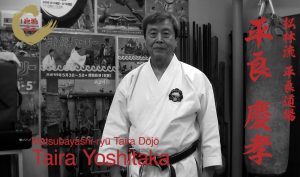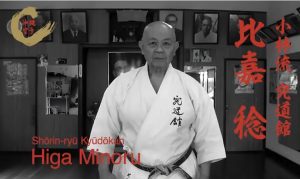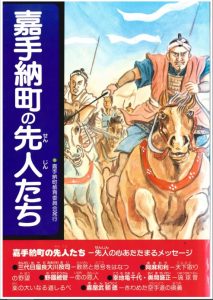In this 9th episode of OKIC’s WA series, Uema Yasuhiro sensei, head of the Shuri Karate Kobudō Preservation Society and Shōrin-ryū Shūbukan demonstrates the beginning of Itosu no Passai (also known as Passai Dai).
View the video at this link: https://www.youtube.com/watch?v=kNNlp0IfcNU
In this fifth episode of the Okinawa Karate “WA” series, Matsubayashi-ryu master Taira Yoshitaka sensei introduces the way Gedan-barai (lower block) is executed and trained in his system.
https://www.youtube.com/watch?v=E8vvXcPBAOU
Go to the “WA” series movies list
A few months ago, a few Shōrin-ryū masters from mainland Japan visited Maeshiro Morinobu sensei in his Shidōkan Musei Juku dōjō for instruction. Recently, Maeshiro sensei has been recognized as a cultural asset holder for Okinawa karate by the Okinawa Prefecture.
Later on, the visiting masters posted some bunkai video on Youtube. Since they are titled in Japanese, overseas karateka may not have the chance to look at these very instructive videos.
We are listing them below together with the said kata performed by Matsujō Tadashi sensei, who also belongs to the Okinawa Shōrin-ryū Karatedō Kyōkai (association).
Please be aware that training should be held under the supervision of a qualified instructor. Our center cannot be held responsible for any injury that may occur through the practice of the contents of these videos.
Passai Dai or Matsumura no Passai – Kata:
https://okinawa-karate.okinawa/kata-movie/naha-shuritekei-passai-dai/
Matsumura no Passai (kata) Bunkai No. 1
https://www.youtube.com/watch?v=6jDn13V_M-A&t=6s
Matsumura no Passai (kata) Bunkai No. 2
https://www.youtube.com/watch?v=wmxuEKMCiPQ
Matsumura no Passai (kata) Bunkai No. 3
https://www.youtube.com/watch?v=bUA5nFxb2ME
Matsumura no Passai (Kata) Bunka No. 4
https://www.youtube.com/watch?v=E7bdDh5mt6g
Matsumura no Passai (kata) Bunkai No. 5
https://www.youtube.com/watch?v=RQEFHlrqoO0
Matsumura no Passai (kata) Bunkai No. 6
https://www.youtube.com/watch?v=20z7DL5JuJ4
Matsumura no Passai (kata) Bunkai No. 7
https://www.youtube.com/watch?v=UJO60BDLyNQ
Matsumura no Passai (kata) Bunkai No. 8
https://www.youtube.com/watch?v=YIyH7Xt2kWA
Some folktales of Yomitan village have been released online. Among them are stories relating to karate master Kyan Chōtoku also known as Chan-mīgwā.
Below we offer a non official translation of the narration.
Title: Chan-mīgwā (Iramina District)
Based on the folktales by Matsuda Nobumasa (born in 1896)
(First folktale)
Chan-mīgwā weighted approximately 50kg, was skinny and at first sight he didn’t look strongly built.
However, he excelled in martial arts and was a very powerful man.
Before the war, when he performed karate at Harayama Shobu (1) in front of the Yomitan village office, his arms and entire body were muscle-tightened like steel.
Everyone was extremely surprised by this superb expert.
Chan-mīgwā was a horse carriage owner by Hīja Bridge.
Once as he went charging rice bags on a horse carriage, carriers from Yonabaru were also present.
As Chan-mīgwā was charging his rice bags slowly as always, the rough Yonabaru carriers got mad and told Chan-mīgwā to “get out of the way. We are going first” and try to start charging their rice bags first.
At that sight, Chan-mīgwā got mad. “What are you saying?! There is an order in things. Don’t behave selfishly!”
So saying, he start kicking the rice bags to put them on the carriage and filled the carriage in no time.
Watching the scene, the Yonabaru carriers realized that they were facing a man with extraordinary power and fluttered by the amazing skills of Chan-mīgwā run away frightened as they were.
(1) Agriculture encouragement contests
(Second folktale starting at 1:49)
And another story…
Chan-mīgwā was teaching karate to the daughter of Yara Rindō
And eventually they felt in love.
One day, as Chan-mīgwā was going as always to the house of the daughter
Some men came pretending that he was trying to take away the Yara daughter and that this behavior couldn’t be accepted.
The young men of Yara came with sticks and altogether chased Chan-mīgwā.
Seeing this, as he was in the vicinity of Hīja Bridge, Chan-mīgwā caught the daughter on his waist and jump on the bridge parapet. The young men did their best to chase him but were incapable of doing so and Chan-mīgwā run away.
Later he and the Yara Rindō daughter became husband and wife.
As you can see, not only being a splendid martial expert, he was a light-footed although being a small person. One day, he escaped by jumping from one roof to the other. It is said that this scene looked like it was a bird flying.
The end!
(The two other folktales are not karate related so forgive us for not translating the narration.)
Extra note:
A similar episode is also introduced in the book "Kadena Town's pioneers" published in 1993 by the Kadena Town Board of Education.
In the 18-page chapter dedicated to Okinawa karate and Kyan Chōtoku is written the following.
“Chōtoku who had a house closed by Hīja Bridge decided to start a business of carrying goods from the port to the Naha port’s warehouse (Tundō). As goods were carried by horse carriage, carriers were called “Basha-muchā” or horse coach owner. The work of a carriage owner was a very heavy labor. Therefore, most of the owners were rough people, and most of them were big men hard to be dealt with. Among them, owners care less of each other. On the way to Naha, while the roads were tight, carriers would not give priority to others and this would often lead to people fighting each other. When arriving at the warehouse, they would fight for the order of delivering their freight. These rough men were confident in their dexterity.”
After this explication, the same episode with the big men from Yonabaru is introduced. However, it is said that Kyan Chōtoku charged sugar bags rather than rice bags doing so not with his feet but using a rokushakubō staff.



